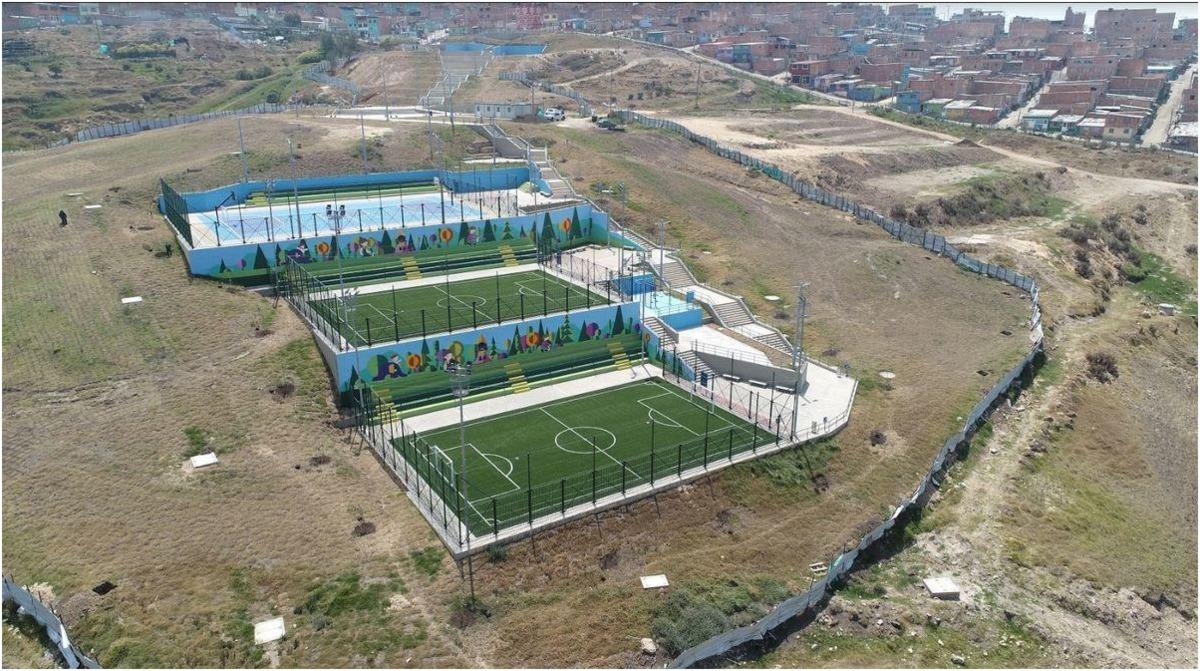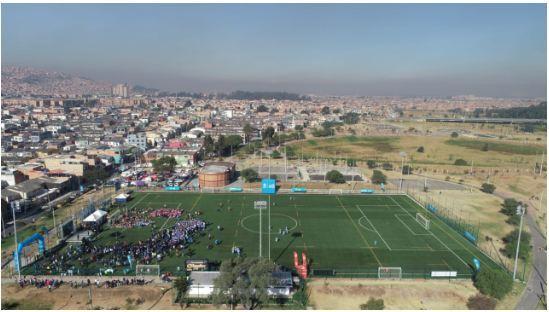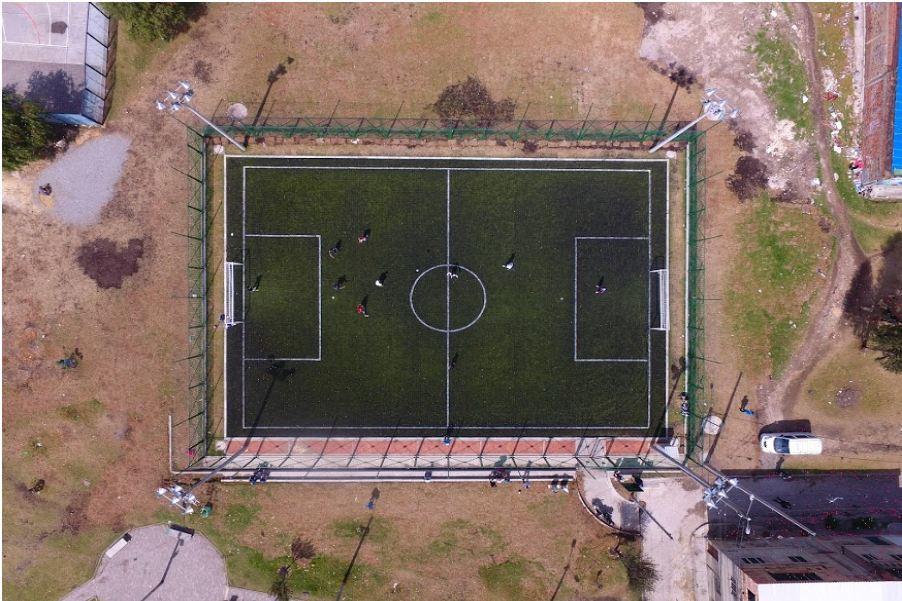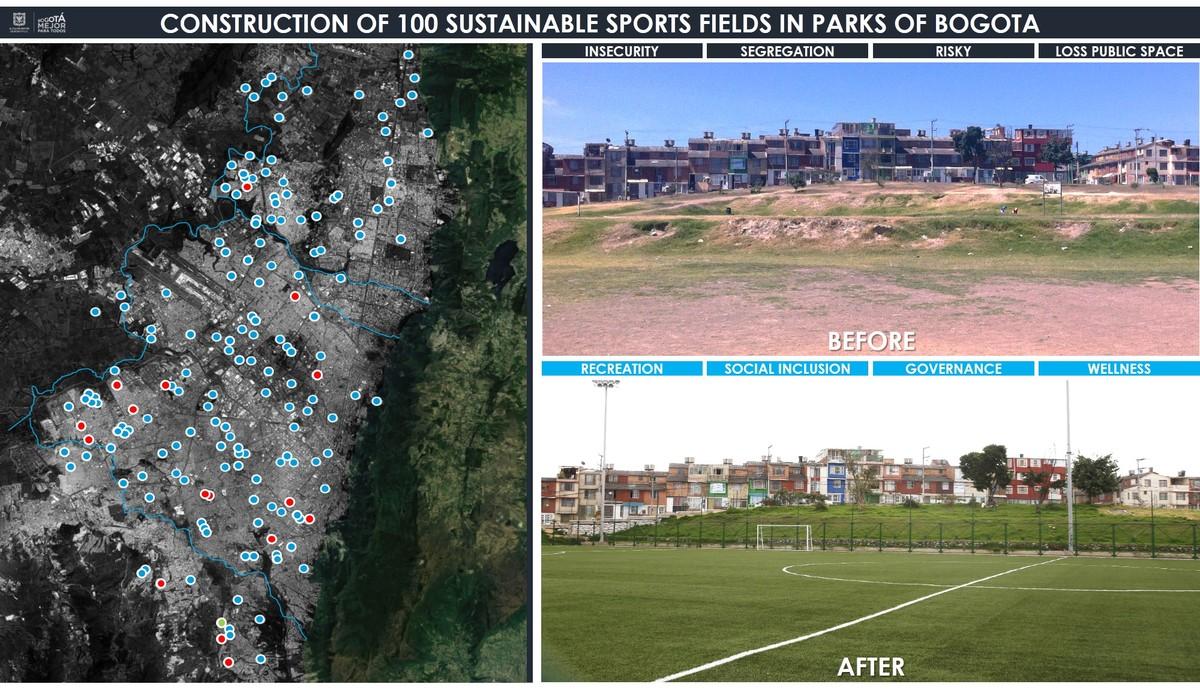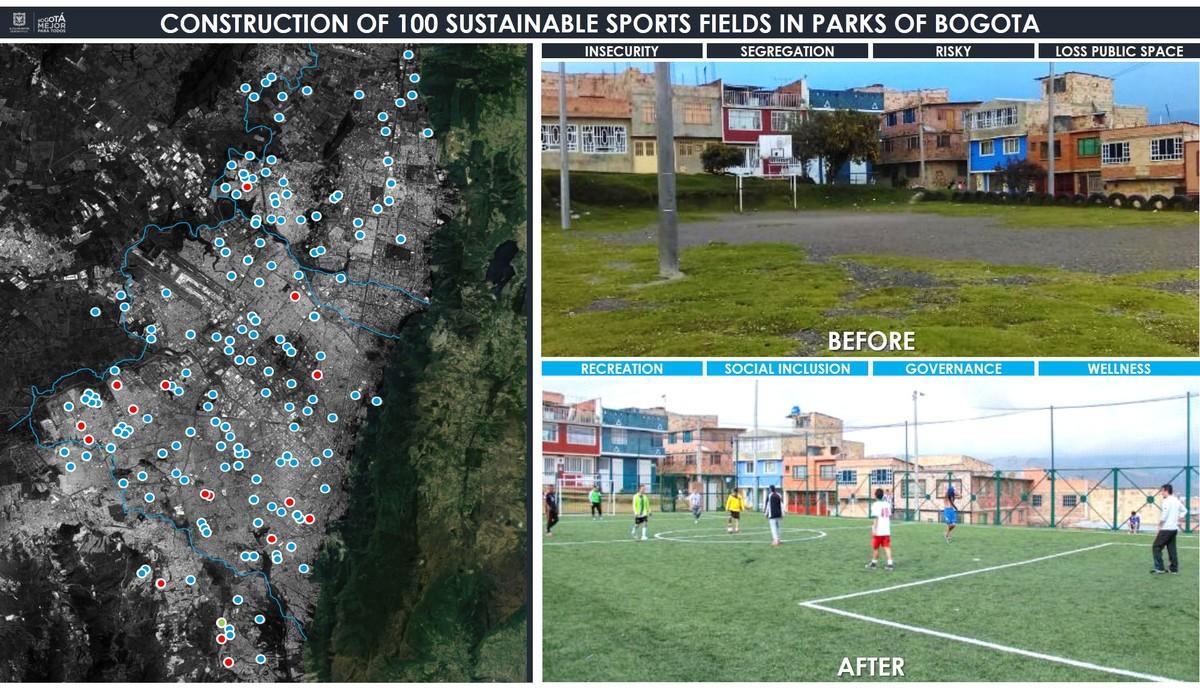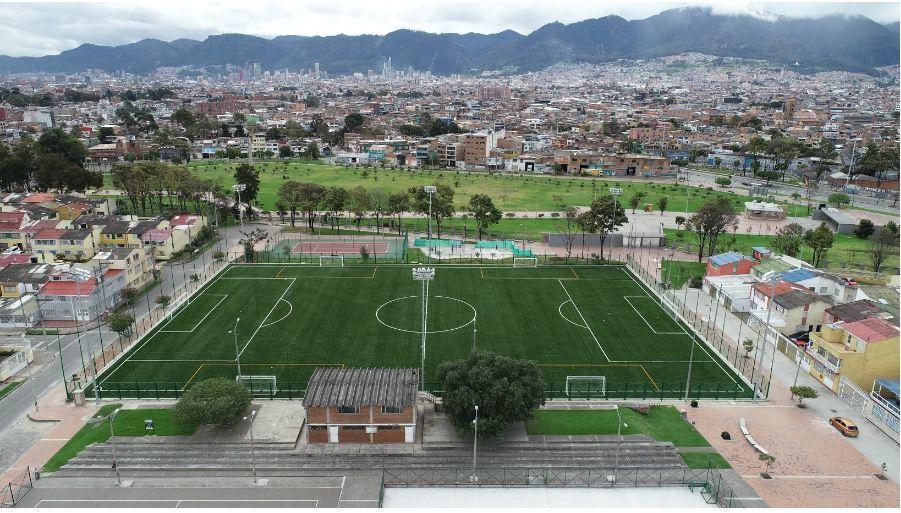Construction of 100 Sustainable, Sports synthetic Fields on Parks in Bogota
Last modified by the author on 20/06/2019 - 17:17
- Year of commitment : 2018
- Address 1 - street : BOGOTA, Colombia
- Diameter : 15
- Sustainable mobility : Pedestrian Mobility, Urban furniture, Accessibility
- Water cycle : Other
- Circular economy and waste management : Reuse, Optimization of ressources
-
25 000 000 €
- Builder
The District Institute of Recreation and Sport (IDRD) - Manager / Dealer
The District Institute of Recreation and Sport (IDRD)
Bogotá city, Colombia’s capital has a population ofaround eight million people, which generates a constant requirement of greenpublic space for the enjoyment of citizens. The District Institute ofRecreation and Sport (IDRD) is in charge of the District System of Parks. Theseare a set of green spaces that act as regulators of the environmental balance,constitute an element of the natural patrimony and contribute to guarantee thefree space destined to recreation, contemplation and leisure of the citizens. However,the high amount of population has as a consequence, a deficit of public andgreen space for the city.
Committed with environmental sustainability andwellbeing of the people, and taking into account the climatic and socialconditions of the city hinder the constant maintenance of green spaces, theIDRD proposed an alternative to generate public space, which consisted indesigning a public investment project between 2016 and 2018, to carry out theconstruction of 100 synthetic fields throughout the city, prioritizing theareas with the greatest population and deficit of public space. Thisintervention increased public space availability in 244,000 m2 of green areas forsports practice and leisure. Also this initiative allows the reuse ofrecyclable materials, reduces water consumption for maintenance, suppress theuse of fertilizers and pesticides, and promotes water regulation.
Progress Status
Delivered
Data Reliability
Self-declared
Funding Type
Public
Website Enterprise / Infrastructure
https://idrd.gov.co/obras-0https://www.idrd.gov.co/noticias/bogota-tiene-100-canchas-sinteticas
Sustainable Development
Testimony / Feedback
Changed his life with the possibility of sport in a synthetic field. His dream of playing football was lost in the streets of the Bronx (drugs hotspot). Today he forges his present after a ball in the synthetic court of El Tunal. "My life is another. Thanks to this possibility my life had a total change. This moment is very important for me and thanks to this field where I spend a good part of my time, I dream of the Colombian shirt to defend its colors, "he says.
Team Titans (handicap people) With courage, perseverance and discipline, they overcame a crisis. Playing sports had been left behind, until a stage opened its doors and the challenge was overcome to mark a story. Disability entered the field from adapted and inclusive sports. They are The Titans and they play in the La Estancia court. "When things are in the mind, the disability goes into the background and there is no impediment and football, in and of itself, is my love," says José Eliseo Suárez, a Titan.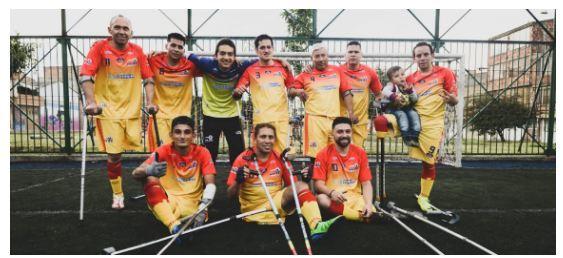
Governance
The District Institute of Recreation and Sport (IDRD)
Local Authority
The District Institute of Recreation and Sport (IDRD)
Other
The District Institute of Recreation and Sport (IDRD)
Public
The construction of synthetic fields, it has allowed the recovery of public space and its effective use by citizens.
It encourages social interaction, the use of free time, the practice of physical activity and the cultural expressions of communities.
The security conditions of the intervened places have improved, generating social appropriation and territorial management.
The city government collects taxes for the operation of the city, part of the resources are used to recreation and sports, and the construction of the 100 synthetic fields.
These fields are built with citizens' money and are free to use for them. However, the organizations sports teams and sports schools pay a rent for the use of the fields, this income allows to perform maintenance and ensure the sustainability of the investment and keep the facilities in good condition.
Sustainable Solutions
- Governance :
- Quality of life :
- Resources :
- Urban project governance
- Proximity services
- Circular economy
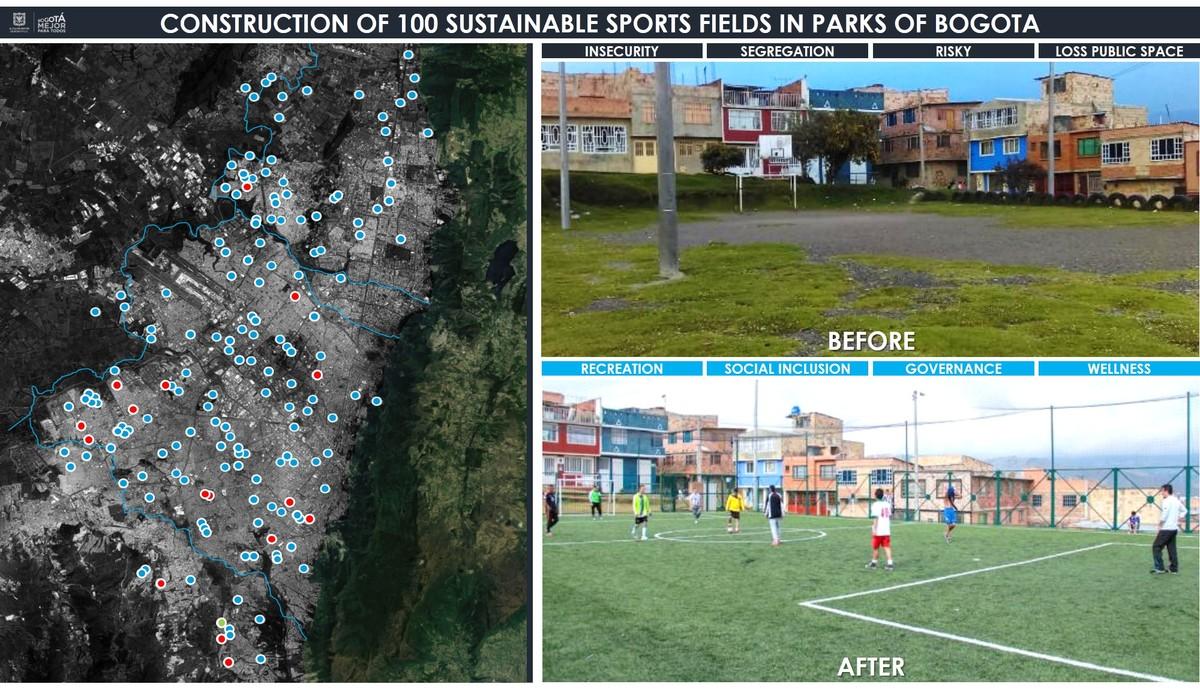
Synthetic turf to recover public space with effective use
Committed with environmental sustainability and wellbeing of the people, and taking into account the climatic and social conditions of the city hinder the constant maintenance of green spaces, the IDRD proposed an alternative to generate public space, which consisted in designing a public investment project between 2016 and 2018, to carry out the construction of 100 synthetic fields throughout the city, prioritizing the areas with the greatest population and deficit of public space. This intervention increased public space availability in 244,000 m2 of green areas for sports practice and leisure. Also this initiative allows the reuse of recyclable materials, reduces water consumption for maintenance, suppress the use of fertilizers and pesticides, and promotes water regulation.
Reasons for participating in the competition(s)
Description
Bogotá city, Colombia’s capital has a population of around eight million people, which generates a constant requirement of green public space for the enjoyment of citizens. The District Institute of Recreation and Sport (IDRD) is in charge of the District System of Parks. These are a set of green spaces that act as regulators of the environmental balance, constitute an element of the natural patrimony and contribute to guarantee the free space destined to recreation, contemplation and leisure of the citizens. However, the high amount of population has as a consequence, a deficit of public and green space for the city.
Taking into account the mentioned issue, the best alternatives for the creation or adequacy of sustainable green spaces that are adaptable to the environmental, socioeconomic and institutional conditions of the city of Bogotá, were analyzed. After that, the IDRD defined the construction of artificial fields as the best alternative, because these encourage the practice of physical activity and sports such as soccer, rugby, football, etc.
Committed with environmental sustainability and wellbeing of the people, and taking into account the climatic and social conditions of the city hinder the constant maintenance of green spaces, the IDRD proposed an alternative to generate public space, which consisted in designing a public investment project between 2016 and 2018, to carry out the construction of 100 artificial fields throughout the city, prioritizing the areas with the greatest population and deficit of public space. This intervention increased public space availability in 244,000 m2 of green areas for sports practice and leisure. Also this initiative allows the reuse of recyclable materials, reduces water consumption for maintenance, suppress the use of fertilizers and pesticides, and promotes water regulation.
Building candidate in the category

Sustainable Infrastructure Grand Prize





